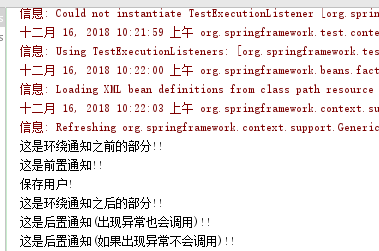一、导包(导入maven的依赖)
<?xml version="1.0" encoding="UTF-8"?> <project xmlns="http://maven.apache.org/POM/4.0.0" xmlns:xsi="http://www.w3.org/2001/XMLSchema-instance" xsi:schemaLocation="http://maven.apache.org/POM/4.0.0 http://maven.apache.org/xsd/maven-4.0.0.xsd"> <modelVersion>4.0.0</modelVersion> <groupId>day2</groupId> <artifactId>day2</artifactId> <version>1.0-SNAPSHOT</version> <dependencies> <dependency> <groupId>org.springframework</groupId> <artifactId>spring-core</artifactId> <version>4.1.4.RELEASE</version> </dependency> <dependency> <groupId>org.springframework</groupId> <artifactId>spring-context</artifactId> <version>4.1.4.RELEASE</version> </dependency> <dependency> <groupId>junit</groupId> <artifactId>junit</artifactId> <version>4.12</version> </dependency> <dependency> <groupId>org.aspectj</groupId> <artifactId>aspectjweaver</artifactId> <version>1.8.13</version> </dependency> <dependency> <groupId>org.springframework</groupId> <artifactId>spring-test</artifactId> <version>4.1.6.RELEASE</version> </dependency> </dependencies> </project>
二、书写配置文件(用的是IDEA,配置文件applicationContext.xml要放到resources文件夹中,不然会报找不到该文件异常)
<?xml version="1.0" encoding="UTF-8"?> <beans xmlns:xsi="http://www.w3.org/2001/XMLSchema-instance" xmlns="http://www.springframework.org/schema/beans" xmlns:context="http://www.springframework.org/schema/context" xmlns:aop="http://www.springframework.org/schema/aop" xsi:schemaLocation="http://www.springframework.org/schema/beans http://www.springframework.org/schema/beans/spring-beans-4.2.xsd http://www.springframework.org/schema/context http://www.springframework.org/schema/context/spring-context-4.2.xsd http://www.springframework.org/schema/aop http://www.springframework.org/schema/aop/spring-aop-4.2.xsd "> <!-- 准备工作: 导入aop(约束)命名空间 --> <!-- 1.配置目标对象 --> <bean name="userService" class="dyh.aop.service.UserServiceImpl" ></bean> <!-- 2.配置通知对象 --> <bean name="myAdvice" class="dyh.aop.springaop1.MyAdvice" ></bean> <!-- 3.开启使用注解完成织入 --> <aop:aspectj-autoproxy></aop:aspectj-autoproxy> </beans>
三、书写要增强的接口和实现类
public interface UserService { void save(); void delete(); void update(); void find(); }
public class UserServiceImpl implements UserService { public void save() { System.out.println("保存用户!"); //int i = 1/0; } public void delete() { System.out.println("删除用户!"); } public void update() { System.out.println("更新用户!"); } public void find() { System.out.println("查找用户!"); } }
四、书写通知类
import org.aspectj.lang.ProceedingJoinPoint; import org.aspectj.lang.annotation.*; //通知类 @Aspect public class MyAdvice { @Pointcut("execution(* dyh.aop.service.*ServiceImpl.*(..))") public void pc(){} //前置通知 //指定该方法是前置通知,并制定切入点 @Before("MyAdvice.pc()") public void before(){ System.out.println("这是前置通知!!"); } //后置通知 @AfterReturning("execution(* dyh.aop.service.*ServiceImpl.*(..))") public void afterReturning(){ System.out.println("这是后置通知(如果出现异常不会调用)!!"); } //环绕通知 @Around("execution(* dyh.aop.service.*ServiceImpl.*(..))") public Object around(ProceedingJoinPoint pjp) throws Throwable { System.out.println("这是环绕通知之前的部分!!"); Object proceed = pjp.proceed();//调用目标方法 System.out.println("这是环绕通知之后的部分!!"); return proceed; } //异常通知 @AfterThrowing("execution(* dyh.aop.service.*ServiceImpl.*(..))") public void afterException(){ System.out.println("出事啦!出现异常了!!"); } //后置通知 @After("execution(* dyh.aop.service.*ServiceImpl.*(..))") public void after(){ System.out.println("这是后置通知(出现异常也会调用)!!"); } }
五、测试
package dyh.aop.springaop1; import dyh.aop.service.UserService; import org.junit.Test; import org.junit.runner.RunWith; import org.springframework.test.context.ContextConfiguration; import org.springframework.test.context.junit4.SpringJUnit4ClassRunner; import javax.annotation.Resource; @RunWith(SpringJUnit4ClassRunner.class) @ContextConfiguration(locations = {"classpath:applicationContextAop.xml"}) public class Demo { @Resource(name = "userService") private UserService us; @Test public void funaop(){ us.save(); } }
测试结果:
